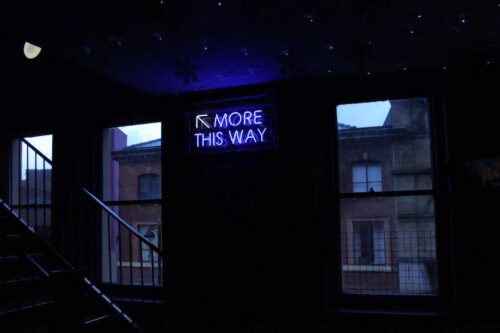There are over 50 different ways in which you can market your consulting business.
A very effective channel can be business exhibitions. They’re a great way to generate leads.
Unfortunately, when I first started exhibiting my consulting business, I didn’t have a clue!
I spent far too much money on my stand, I didn’t do the right things to attract the right audience, I had no plan beyond simply turning up, and I chose the wrong events!
To help you to avoid these mistakes, in this article I’m going to layout 15 key considerations to ensure you make exhibiting your consulting business a success.
They are as follows:
Do your research
The first thing to do when exhibiting is to find the right events to exhibit at.
To know this, you need to do some research.
Start by looking online to find relevant industry events. Ask your existing audience on social media what events they’ve attended in the past. Talk to friends, and current and former colleagues. Ask around at local networking events, look in industry press.
Once you’ve identified potential events, attend them as a delegate. There’s no better way to understand an event than first hand experience.
Get an idea of how many people attend.
See how much interaction and engagement there is between exhibitors and delegates. Talk to exhibitors and ask them how it’s going; whether they’ve exhibited there before; and whether they’ll come back to exhibit next time around.
Make a note of the types of business that are getting the best traction.
And be realistic about where you can afford to exhibit. The higher the number of attendees, and the bigger the names of any speakers, the higher the cost will be to exhibit.
For the fledgling firm, I recommend starting small, maybe at a local Chambers of Commerce event.
Such an event would have a wide diversity of exhibitors and attendees, and it’s unlikely to solely have your target audience, but it will give you the chance to earn your spurs. To get a feel for what it is like exhibiting.
Before signing up to exhibit at an event, talk to the event organisers and find out:
- Who the attendees typically are? Do they match the profile of your ideal client by sector, seniority level, geography, organisation size, etc.
- How many people typically attend?
- Who’s going to be speaking on the day?
- What was the feedback from previous events?
You should also look online yourself to find unbiased reviews.
Determine if your ideal clients will be there, and/or people that could otherwise refer you to your ideal clients.
Return to Top
Choose your pitch
Don’t put baby in the corner!
Find out the floorpan, and choose a good spot before you sign-up.
The better locations will command a higher price, but it could make or break the return on investment of the event.
Ideally grab a position where there’s going to be the highest footfall. That could be next to a central meeting area; a coffee stall; the entrance/exit to the exhibit; or en-route to the conference hall.
Don’t make the mistake of choosing a cheap seat, where you’ll risk being tucked away in a corner with limited footfall.
If you do find yourself in a poor location, here’s what to do: Get out of there!
Get off the stand. Go out and find your target audience.
Hand-out flyers with your stand number on; give people a compelling reason to go and visit your stand. And minimally staff it. Don’t have loads of people standing around, instead get your team out and about where the people are.
Return to Top
Build your stand
The stand itself does not need to be anything too fancy.
Leave the huge stands to the huge companies with the big budgets!
It wouldn’t make sense for your small or micro consulting business to have an expensive stand. That would be like owning a Range Rover whilst living in the worst part of town!
A simple banner stand is fine. But be conscious of the layout.
As you can see in the picture below from my first exhibit, I had writing at the bottom of my banner stand that was never going to be able to be read!

Keep it simple, keep it eye catching, and keep any text in the top half.
Make your stand welcoming.
For my first stand I bought some cheap but reasonable looking stools and I tried to create the feel of people having a conversation in a coffee shop.
By sitting higher up on stools, it created more of a friendly and engaging feel.
Whatever you do, don’t create physical barriers. DO NOT have a table that you sit behind. That’s fine if you’re selling fairy cakes at a school fete, but it has no place in a business exhibition.
And don’t sit down unless you’re in a conversation with somebody.
Return to Top
Be an extrovert for the day
Running a stand requires a bit of extroversion.
Whether you like it or not, you need to drive people to your stand. They’re unlikely to just mosey on by and take a look. You need to get out there and grab them.
Now I’m not suggesting physical force, or scantily clad women (I can’t believe that approach is still deployed in this day and age), and neither am I suggesting you jump in front of people with a clipboard like a chugger on Tottenham Court Road, but you do need to engage with people as they walk past.
Get out there and ask them a question.
Make it a pertinent question that creates immediate intrigue in your business, whilst at the same time helps you to qualify whether or not you should be spending time speaking to them.
For example, when it comes to my coaching business, I might say, “Are you a consulting business owner?”.
Return to Top
Dress to impress
But don’t frighten them off!
I probably over-dressed in the picture above. I was wearing my best corporate attire, but I probably looked too ‘ready’ to do business.
You must be approachable and also look professional. It’s a tough balance, but one that can be more easily achieved through smart-casual attire.
It really depends on the event. Ideally, you’ll match the attire of the majority of attendees.
Remember, you’re wanting to make people feel comfortable – like they’re having a chat in a coffee shop.
Be warm, be approachable, be like them.
Return to Top
Be prepared for conversations
Be prepared for conversations
Practice your elevator pitch in advance of the event.
Make sure you’re very clear when someone comes to your stand and asks, “What do you do?”.
And remember, be client focused i.e. we help “this type of client” resolve “these core problems” through our “proprietary system/service/product.”
Be ready to start conversations with people. There’s nothing wrong with a bit of small talk. How about:
- “What brought you to this exhibition today?”
- “How have you found the event so far?”
- “Has anything that you’ve seen or heard really stood out to you today?”
Return to Top
Don’t waste money on stupid stuff!
How many times have you been to an exhibit and been handed a carrier bag full of bumph. You then walk around the exhibit filling your bag with even more junk.
If the exhibitors are lucky, the bag full of junk gets all the way back your home or office, where it sits for a few days, weeks or even months before being dutifully recycled!
None of this hardcopy stuff is necessary!
It was all a big waste of time and money.
If you haven’t realised it yet, we’re in the digital age. People consume stuff on a screen – whether it’s their desktop, a tablet, or on their mobile.
Get contact details so that you can share stuff via email. That way you gather much more marketing intelligence than simply allowing people to grab stuff and run!
The only thing you should have printed is your business cards. And they should be digitally optimised too. A useful way to do this is by printing a QR code on the back which can link directly to a free guide or other resource on your website.
Return to Top
Take a team
It is unbelievably tiring running an exhibition stand all day long! It can also be great fun, but it really does take its toll.
That’s why you mustn’t attempt it on your own. Take a team, even if it’s only one other person.
You want your stand manned at all times, so you need at least 2 people, unless you can somehow miraculously go an entire day without needing the toilet!
Rotate in shifts. Standing in the same spot all day is fine if you’re a Queen’s Guard, but even they’re only expected to be on duty for 2 hours at a time.
With your fellow exhibitors, take turns walking the floors, attending talks, and manning the stand.
Return to Top
Entice people in
Tell people that you’re going to be there – in advance!
There’s nothing more demotivating than having an exhibition stand with no visitors. But if people don’t know that you’re there, they’re unlikely to stop by! Don’t just rely on the people in the room to be interested in your services.
Once you commit to an exhibition, the first thing you should do is to let people know in advance that you’re going to be there! Advertise your attendance in your email newsletter; put an announcement up on your website; post status updates about it on social media.
Do everything you can to drive people to your stand.
It makes for a great reason to get in touch with those contacts that you’ve neglected!
Find out if any of your existing network is going to be there.
If so, invite them to your stand, and if they’re an important existing client or a hot prospect, arrange to have a coffee with them.
Maximise the opportunity of getting in front of the client or prospect whilst they’re away from the distractions of their office.
And always schedule the next meeting. Keep in control of the conversation. (I wrote a recent article on this very issue).
Return to Top
Network like crazy
Often there are breakfast networking events for those exhibiting. Make sure you go to these as you can get the opportunity to deliver your 60 second pitch.
This is great for others to know what you’re all about, and potentially to refer traffic your way.
Be nosey! Get out around the exhibition early and find out who else is there.
See if there’s any stands with synergistic clients. They could make for great referral opportunities.
Introduce yourself to the main person on that stand and see if there’s collaboration opportunities throughout the day.
I’m still in touch with someone I met at the very first exhibition I did. We’ve since worked together as I’ve used his team as subcontractor on a couple of projects. We’ve also referred business to each other.
Exhibitions present a great opportunity to build these types of relationships. It’s not all about finding your ideal clients at the event itself.
Return to Top
Give a talk
One of the most effective ways to drive people to your stand is to give a talk at the event.
Aim to get a speaking slot at the time where there is peak attendance. You probably don’t want to be giving a talk at the very beginning or the very end of the day when audiences may be smaller.
The same goes for the lunch period, so that doesn’t leave many time slots.

Remember that the whole purpose of exhibiting is to drive sales leads. So any talk must be well thought through and integrated with your stand.
Here’s how I recommend you approach it:
- Give a talk on the core problems that your ideal clients are facing and that you have a solution for.
- At the end of the talk provide a Call To Action (CTA) that offers something for free. That something should lead to interest in your core service. You may offer a free on-site review, or a free call. Whatever it is it needs to be of high value. Depending on the cost to you of delivering it, you may need to limit it to, say, the first 20 that apply, or you put names in a hat and do a prize draw or something similar. Provide a unique url on your slides, and also invite people back to your stand.
- Have a down-sell free offer. For those people that perhaps aren’t ready to avail of your core service, they might instead be interested in a free guide for instance. Offer them the chance to get something that is exclusively available from your stand. When they’re there you can exchange business cards and capture their contact details.
- For those people that don’t want either of the above two offers, but might still be your ideal client, provide a url at the end of your presentation that provides another free resource – perhaps a different guide or a checklist. Something relevant to both your talk and your core service offering. This should be gated content – that is, it requires an email address in order to download it. However, be sure to not fall foul of GDPR regulations.
Attend other people’s talks
When you’re at an exhibition your primary skill needs to be to engage people in conversation. One way to do this is to leverage other people’s talks.
Utilise social media – especially twitter as there’s likely to be an event hashtag.
Comment on the talks of others. If you disagree, then politely and professionally do so. Your contrarian views may drive your ideal clients to your stand off the back of someone else’s talk.
Or maybe you have something complimentary to say, and that too drives people to your stand.
Return to Top
Avoid gimmicks
Glass of champagne?
When I did my first exhibition I was a complete novice.
Instead of providing really valuable give-aways related to my core services, I had the cliched free bottle of champagne based on dropping your business card in the box and prize draw at the end of the day.
This is, quite frankly, a stupid idea! That is unless you own a champagne business, in which case it’s probably a great idea!
You want to collect business cards, and therefore contact details, of people that have the problems that you are an expert in resolving.
Your aim is not to collect business cards from people who are solely interested in the chance of a free bottle of champagne!
Cake anyone?
At the time I did my exhibition my wife had a cake baking business. And in all honesty, she made some damn good cupcakes! So I commissioned her to make me a batch that included the company logo on top.
This was not the worst idea to get people to come to the stand (and it generated business for my wife';s business!) but it still only really qualified people who were interested in cake, rather than qualifying people interested in the services that I had to offer!
Return to Top
Get leads
As you’ll have seen thus far, the whole purpose of exhibiting is to get sales leads. Your stand, and ideally your talk, is designed to entice the right people in who will willingly share their contact details.
This is first base!
By leaving you their contact details, you are being invited to develop a relationship with them.
If you’re really disciplined, you can place the cards that you receive, or the contact details that you make note of, into different groupings – Hot leads, potential leads, limited interest.
Your first action after the event is to follow up.
Return to Top
Follow up
Why do so many people do such a bad job of following up?
Maybe it’s fear of rejection, or fear of failure, or even fear of success.
It doesn’t matter which, not following up is not only unprofessional, but the fastest way to end up with zero clients! That’ll mean the entire event was a waste of time.
Ideally you’ll have segmented your leads as you received them.
For those people who you had a conversation with; who expressed interest in your services; and with whom you think there’s both a need for your services and that you have the skills and expertise to serve them, follow up ideally with a phone call.
Your aim on the call is to secure a face-to-face meeting with them so that you can explore opportunities to help them.
If you can’t get them on the phone (try over the following 5 business days first), then revert to email. Make it clear when you’ll next be in touch and by which method i.e. “I’ll follow up this email with a call to your mobile tomorrow morning between 10am and 12 noon. If that time doesn’t work, let me know a time that does?”
If you made a promise to anybody to send on something of value, such as a guide or other free resource, then make sure you do it.
Send an email saying it was great to meet them, and forward on a link or the resource itself as promised.
Then plan a further follow up.
For example, you might send them a guide then say something like, “Here’s a copy of the guide I promised you. I’m certain there’s some very relevant and valuable stuff in there for you. I’ll follow up with a call on Friday morning to see how you got on.”
If you simply collected a business card, but didn’t create much of a connection, then start by building the connection.
Reach out with a LinkedIn connection request, stating that you met briefly at the exhibit.
Offer a link to a free resource that you think might be relevant. Show interest in them by following their social media profiles.
Finally, be consistent, persistent and patient.
If you get no response, then follow up again a few days later.
Return to Top
Measure up
So is exhibiting the right marketing channel for your consulting business? Only time will tell, and only if you measure the success.
For example, how many of the leads that you generate turn into face-to-face meetings?
How many of those meetings result in the opportunity to submit a proposal?
How many of those proposals related to prospects met at the exhibitions result in a sale?
What is the potential lifetime value of these clients?
Only once you know these numbers - which will take time and a few exhibitions to determine - will you be able to confirm whether exhibitions are worthwhile.
It might take only one event. It may require 10. Just like every other marketing channel, it is neither guaranteed nor easy. It takes commitment.
Return to Top
In Conclusion
Hopefully you can now see that there’s a lot to do to ensure that you make exhibitions a really great source of leads for your consulting business.
They’re not suitable for every business, but for those that they are, they need to be crafted such that they form one element of a wider omnichannel marketing strategy.
You must maximise and optimise every element of an exhibition in the hope to get any sort of return on investment. You might get lucky by just turning up, but what you really want to do is increase your probability of success!





